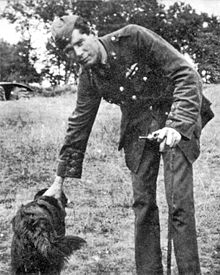Edward Mannock
Major Edward Corringham "Mick" Mannock (born May 24, 1887 in Ballincollig near Cork , Ireland , † July 26, 1918 near Béthune , France ) was a British fighter pilot of the First World War . Posthumously he was awarded the Victoria Cross .
Life
He is considered a particularly talented pilot and patrol leader. He was Britain's most successful fighter pilot in World War I and is sometimes mistakenly referred to as the most successful Allied aviator.
Before the war began, Mannock worked as a telephone technician in Turkey, where he was interned at the start of the war. After his repatriation due to his poor health, he volunteered for the Royal Flying Corps . There he became a student of the famous James McCudden . In April 1917 he was named No. 40 Squadron, where he initially flew Nieuport fighters with little success. However, after getting used to the job, he became a successful pilot who put a lot of thought into optimizing this new weapon. Here there are parallels to the German ace Oswald Boelcke .
In February 1918, Mannock became the No. 74 Squadron as squadron leader and flew the relatively new SE 5a there . It was with this aircraft that Mannock's ascent began, although there were initially gun and engine problems.
Mannock's greatest period began on July 3, 1918, when he was appointed commander of No. 85 Squadron was appointed. Extremely successful as a fighter pilot and very popular with his soldiers, he became more and more depressed. He was now obsessed with the thought of his imminent death. When asked about his goals after the war, he only said: "For me there will be no afterwards!"
Mick Mannock was an extremely sensitive personality and now suffered more and more from severe anxiety. He was particularly afraid of being shot down while burning in a dogfight. He gave assurances that in such a case he would immediately kill himself with a pistol. In the last weeks of his life, his steadily increasing hatred of the enemy became almost pathological: When asked why he once caught fire on a shot down plane, he replied: "It's better if the pigs are dead!"
As a squadron leader, Mannock knew how to give self-confidence like no other, young inexperienced pilot. He often foregone the crediting of a kill and left the aerial victory to a beginner.
In the early morning of July 26, 1918, he took off, accompanied by Lt. Donald C. Inglis, who had not yet scored a kill. After he shot down a German two-seater, German infantry shot it close to the ground. Suddenly his SE 5a with the serial number E1294 caught fire and exploded on the ground over German territory. It is not known whether he was able to reach for the pistol, as announced in such a case. It is also not entirely clear where Mannock was buried. His grave is thought to be lost.
Controversial number of his kills
After the war, Mannock's number of aerial victories was given as 73, a number that can still be found in various sources today. Sometimes it is even claimed that in reality he had over 100 kills. With this number he was only 7 kills behind Manfred von Richthofen and exactly one shot above the Canadian Billy Bishop , who is now considered the most successful fighter pilot in the British Empire . With a probability bordering on certainty this statement is wrong - even higher statements are certainly propaganda. Mannock's official kill number was only 47, he himself stated 51 victories, according to some sources even 50. Another uncertainty is the fact that the British at the end of the World War shared air victories - when several pilots of a squadron were involved in the downing of an enemy aircraft - counted as a kill for each individual pilot. The Germans attributed each shot to only one fighter pilot. Recent analyzes by World War II researchers speak of 61 aerial victories if shared aerial victories are included ( Above the Trenches , C. Shores 1990). That number is widely accepted today. The wrong number 73 probably goes back to the author Ira Jones, a student of Mannock. He is reported to have disliked Billy Bishop.
Others
Due to temporary blindness as a child, his vision was also somewhat impaired as an adult.
See also
literature
- Arch Whitehouse: Flieger-Ase 1914-1918 . Motorbuch-Verlag, Stuttgart 1970, pp. 273-276.
Web links
- The Aerodrome: Edward Mannock
- Major Mick Mannock (detailed biography)
- Western Front Association: Major 'Mick' Mannock, VC: Top Scoring British Flying Ace in the Great War
- Commonwealth War Graves Commission
- Reference only (PDF file; 5 kB)
- Edward 'Mick' Mannock: World War I RAF Ace Pilot Article by O'Brien Browne
| personal data | |
|---|---|
| SURNAME | Mannock, Edward |
| ALTERNATIVE NAMES | Mannock, Edward Corringham (full name); Mannock, Mick (nickname) |
| BRIEF DESCRIPTION | British fighter pilot of the First World War |
| DATE OF BIRTH | May 24, 1887 |
| PLACE OF BIRTH | Ballincollig near Cork , Ireland |
| DATE OF DEATH | July 26, 1918 |
| Place of death | near Béthune , France |

